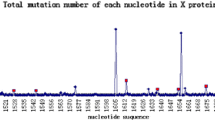Abstract
Purpose
To determine whether the genomic changes in hepatitis B virus (HBV) affect the clinical outcomes of hepatocellular carcinoma (HCC) in patients with HBV-associated HCC treated with curative surgical resection.
Methods
A total of 247 patients with HBV-associated HCC were treated with curative surgical resection. They were followed regularly for a median of 30 months. The whole X, S, basal core promoter (BCP), and precore regions of HBV were sequenced.
Results
The genomic changes such as the G1896A at precore, the A1762T/G1764A at BCP, the C1653T and the T1753V at X gene, and pre-S2 deletion were not significantly associated with postoperative recurrence of HCC or survival of patients after curative resection. However, in univariate analysis, younger age, elevated serum α-fetoprotein level, elevated serum alanine aminotransferase level, larger tumor size, microvascular invasion, and advanced Cancer of the Liver Italian Program stage were closely associated with shorter survival after surgical resection. In multivariate analysis, only microvascular invasion revealed to be an independent risk factor of postoperative recurrence (relative risk [RR] 5.406; P < 0.001); the independent risk factors of shorter survival appeared to be infiltrative type (RR 5.110; P = 0.032), larger tumor size (RR 1.976; P = 0.047), and microvascular invasion (RR 6.118; P < 0.001).
Conclusions
The postoperative recurrence or survival period may not be affected by the genomic changes at the precore, BCP, X, and pre-S2 regions in HBV of genotype C2 in patients with HBV-associated HCC treated with curative surgical resection. Rather, it may be closely associated with tumor characteristics, such as the size and type of HCC or presence of microvascular invasion.



Similar content being viewed by others
References
Liu S, Zhang H, Gu C, et al. Associations between hepatitis B virus mutations and the risk of hepatocellular carcinoma: a meta-analysis. J Natl Cancer Inst. 2009;101:1066–82.
Pujol FH, Navas MC, Hainaut P, et al. Worldwide genetic diversity of HBV genotypes and risk of hepatocellular carcinoma. Cancer Lett. 2009;286:80–8.
Yuan JM, Ambinder A, Fan Y, et al. Prospective evaluation of hepatitis B 1762(T)/1764(A) mutations on hepatocellular carcinoma development in Shanghai, China. Cancer Epidemiol Biomarkers Prev. 2009;18:590–4.
Yang HI, Yeh SH, Chen PJ, et al. Associations between hepatitis B virus genotype and mutants and the risk of hepatocellular carcinoma. J Natl Cancer Inst. 2008;100:1134–43.
Fang ZL, Sabin CA, Dong BQ, et al. Hepatitis B virus pre-S deletion mutations are a risk factor for hepatocellular carcinoma: a matched nested case-control study. J Gen Virol. 2008;89:2882–90.
Murakami S. Hepatitis B virus X protein: a multifunctional viral regulator. J Gastroenterol. 2001;36:651–60.
Bruix J, Llovet JM. Prognostic prediction and treatment strategy in hepatocellular carcinoma. Hepatology. 2002;35:519–24.
Mann CD, Neal CP, Garcea G, et al. Prognostic molecular markers in hepatocellular carcinoma: a systematic review. Eur J Cancer. 2007;43:979–92.
Su H, Zhao J, Xiong Y, et al. Large-scale analysis of the genetic and epigenetic alterations in hepatocellular carcinoma from Southeast China. Mutat Res. 2008;641:27–35.
Qin LX, Tang ZY. The prognostic significance of clinical and pathological features in hepatocellular carcinoma. World J Gastroenterol. 2002;8:193–9.
Pawlik TM, Delman KA, Vauthey JN, et al. Tumor size predicts vascular invasion and histologic grade: Implications for selection of surgical treatment for hepatocellular carcinoma. Liver Transpl. 2005;11:1086–92.
Poon RT, Ng IO, Fan ST, et al. Clinicopathologic features of long-term survivors and disease-free survivors after resection of hepatocellular carcinoma: a study of a prospective cohort. J Clin Oncol. 2001;19:3037–44.
Chan HL, Hui AY, Wong ML, et al. Genotype C hepatitis B virus infection is associated with an increased risk of hepatocellular carcinoma. Gut. 2004;53:1494–8.
Chen JD, Liu CJ, Lee PH, et al. Hepatitis B genotypes correlate with tumor recurrence after curative resection of hepatocellular carcinoma. Clin Gastroenterol Hepatol. 2004;2:64–71.
Ahn SH, Yuen L, Han KH, et al. Molecular and clinical characteristics of hepatitis B virus in Korea. J Med Virol. 2010;82:1126–34.
Asim M, Malik A, Sarma MP, et al. Hepatitis B virus BCP, Precore/core, X gene mutations/genotypes and the risk of hepatocellular carcinoma in India. J Med Virol. 2010;82:1115–25.
Poon RT, Fan ST, Ng IO, et al. Different risk factors and prognosis for early and late intrahepatic recurrence after resection of hepatocellular carcinoma. Cancer. 2000;89:500–7.
Imamura H, Matsuyama Y, Tanaka E, et al. Risk factors contributing to early and late phase intrahepatic recurrence of hepatocellular carcinoma after hepatectomy. J Hepatol. 2003;38:200–7.
Wu JC, Huang YH, Chau GY, et al. Risk factors for early and late recurrence in hepatitis B-related hepatocellular carcinoma. J Hepatol. 2009;51:890–7.
Chen CH, Hung CH, Lee CM, et al. Pre-S deletion and complex mutations of hepatitis B virus related to advanced liver disease in HBeAg-negative patients. Gastroenterology. 2007;133:1466–74.
Fattovich G, Bortolotti F, Donato F. Natural history of chronic hepatitis B: special emphasis on disease progression and prognostic factors. J Hepatol. 2008;48:335–52.
Mun HS, Lee SA, Jee Y, et al. The prevalence of hepatitis B virus preS deletions occurring naturally in Korean patients infected chronically with genotype C. J Med Virol. 2008;80:1189–94.
Sumie S, Kuromatsu R, Okuda K, et al. Microvascular invasion in patients with hepatocellular carcinoma and its predictable clinicopathological factors. Ann Surg Oncol. 2008;15:1375–82.
Cha C, Fong Y, Jarnagin WR, et al. Predictors and patterns of recurrence after resection of hepatocellular carcinoma. J Am Coll Surg. 2003;197:753–8.
Author information
Authors and Affiliations
Corresponding author
Additional information
The first two authors contributed equally to this article, and both should be considered first author.
Rights and permissions
About this article
Cite this article
Mathews, P., Lee, D., Chung, YH. et al. Effects of Genomic Changes in Hepatitis B Virus on Postoperative Recurrence and Survival in Patients with Hepatocellular Carcinoma. Ann Surg Oncol 20, 1216–1222 (2013). https://doi.org/10.1245/s10434-012-2706-7
Received:
Published:
Issue Date:
DOI: https://doi.org/10.1245/s10434-012-2706-7




